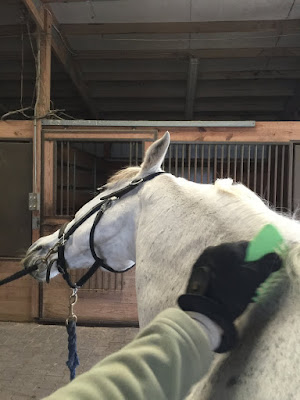Also strongly contra-indicated: having your dressage horse try to throw himself down the 15 foot bank and into the river.
And do you know what's in those lovely joint injections that help many older horses? Steroids (and hyaluronic acid, but details).
So when Taran came up off on the right front and it blocked to the coffin joint, injecting the joint seemed like a good option... just, not with steroids. A couple of years ago, we would have been stuck with either retiring him or trying steroidal injections and hoping he didn't have a laminitic episode, but these days we have other options.
Having lots of blanket options is also good, so you can wear your fluffy 400g fill when it's under 50 degrees.
There's a technique called ProStride (yes it's trademarked) that's actually IRAP + PRP, plus some HA mixed in for good measure. They can spin down your horse's blood in about 20 minutes right at the barn, and the injection is done immediately. It does take 2-3 weeks to see the full effect, but it supposedly lasts up to a year or more, which is much longer than traditional steroidal injections (3, 4).
The down side, of course, is cost. Traditional steroidal injections have run me $130-150, not including farm call and tranqs to do the injection. ProStride was $500 for the injection alone.
Fortunately this dual-use mane comb/horse scratcher was only $0.50, so obviously I had money for injections.
But honestly? I wasn't willing to risk possible laminitis/founder that a traditional joint injection would bring. If that had been our only option, I would have just retired him. It's just not worth it.
Whoa there buddy.
1. https://thehorse.com/129313/cushings-disease-in-horses/
2. http://www.laminitis.org/laminitis.html
3. http://virginiaequinepllc.com/exciting-new-joint-therapy-prostride/
4. https://www.ncbi.nlm.nih.gov/pubmed/24471750





Great information! I didn't know any of those things when Promise was around. I was pretty sure she had Cushings, but was told there was no actual test for it (this was 8 or 9 years ago. I know there is a test now, but I don't know how long it's been around!). We put her on Pergolide and watched for improvements. After she injured herself, I ended up injecting her stifle 2 or 3 times trying to get her sound. I can't recall now what we used, but I think it was a pretty standard steroid joint injection. She didn't founder, so she either didn't have Cushings or I got really, really lucky on that front! Scary to think about!
ReplyDeleteFingers crossed the injection works for him!
I think ProStride was first used around 2014, so it's pretty new.
DeleteT has had one steroidal injection since he was diagnosed with Cushings, and he had an event line on his feet after it, so there was indeed a mild bit of laminitis. I'm glad you didn't have that experience with Promise! Apparently it can be very dependent from horse to horse.
I have heard of ProStride but didn't realize it was just compounded right there in the centrifuge, interesting. But that's good for folks to know about for non-steroid horses! The scientist in me can't help but be curious about the relative effect of the different components, i.e. what would be the difference between all 3 vs just doing HA alone (which could give people some more affordable options maybe & also require less equipment).
ReplyDeleteBummer to hear about the right front, but I hope he is back up to speed soon with the renewed lube, the left sounds promising! And I'm only laughing at little at 400 g at 50 degrees - bc I'm also drooling in envy at the appearance of dry spots on the ground. Even my hilltop is mud soup right now, sigh.
The dry spots are all gone... we're currently working on going back to the inland sea that once covered most of Texas. Fun times!
DeleteI surely hope the Pro-stride works so you and Taran can continue your amazing progress. Thanks for the links. Always glad to learn more about these crazy metabolic conditions.
ReplyDeleteMy dearly departed Sweetpea (Gulf Stream Retriever) was stricken with Cushing's. Over the course of four years I questioned several times when my vet wanted to treat her awful itching with steroids - arguing that they should be contraindicated. He was highly offended. I did tons of research, but what do I know not being a vet and all...
Sometimes there just aren't a lot of options, you know? You gotta do what works with the least risk. Cushings is a tough disease for both dogs and horses, that's for sure.
DeleteI guess the cost of the treatment is worth it considering all the time and money you have invested in training. I hope it works for Taran. So cool that you were learning piaffe!
ReplyDeleteHere's something frustrating. Harley developed Cushings from steroid treatment for his coughing. I think the symptoms go away when he is not meditated, but he needs meds quite often. I talked to the vet about other options, but he is taking the most effective medication for his condition and obviously he needs to be able to breathe. He will be 21 in March!
Well, it's hard to find another almost 4th level horse just lying around, unless you have $50K or so to spend.
DeleteI'd read that steroids can cause Cushings, and I'm so sorry that happened with Harley. I hope you can find the right balance that works for him - sounds like you're in a tough spot! Best of luck and please give Harley a hug from us... I miss hearing about him!